[CITG127 - ASSESSMENT] - How to Go About Setting Up Your Businesses
VerifiedAdded on 2022/09/10
|8
|2340
|36
Assignment
AI Summary
Contribute Materials
Your contribution can guide someone’s learning journey. Share your
documents today.
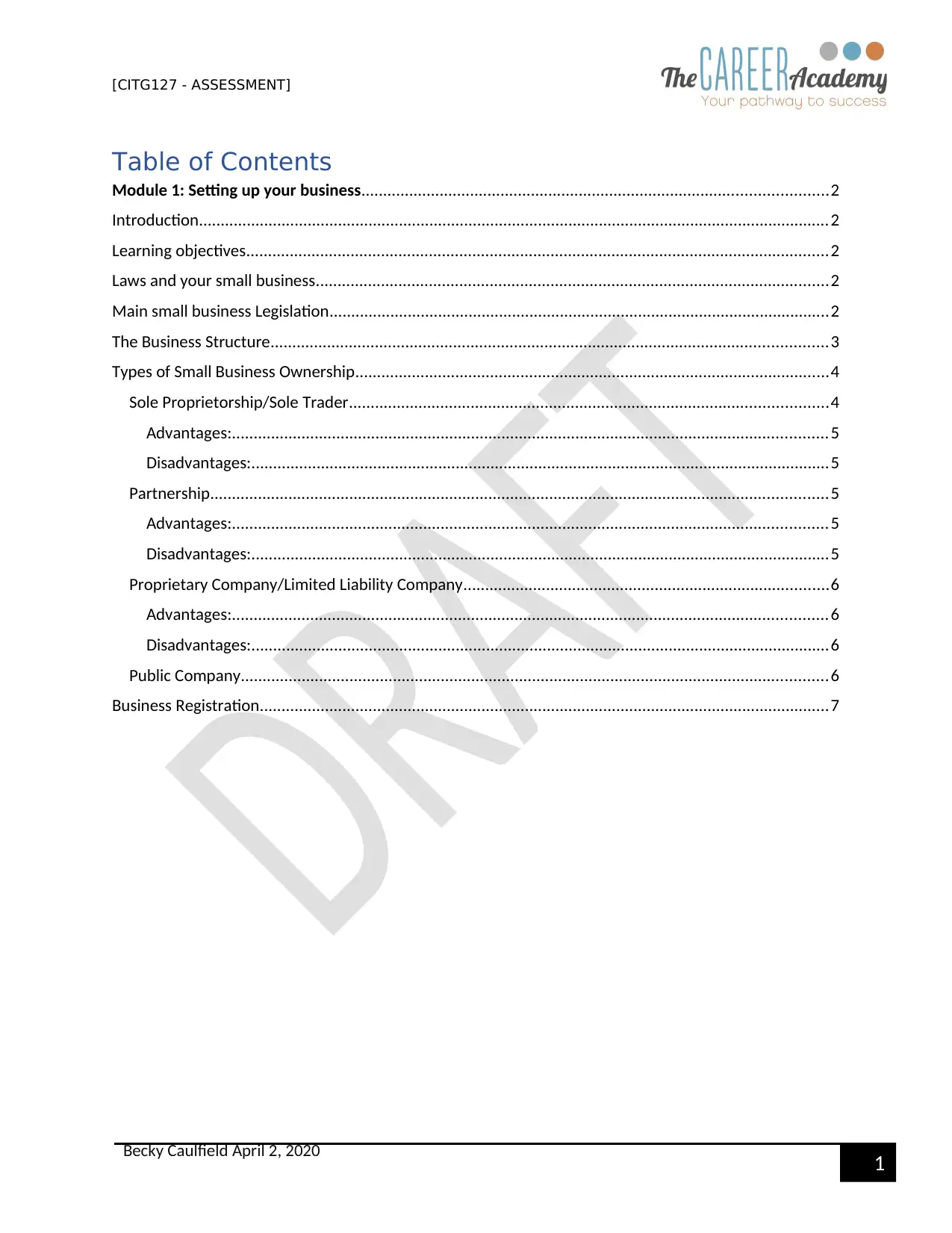
1
Becky Caulfield April 2, 2020
[CITG127 - ASSESSMENT]
Table of Contents
Module 1: Setting up your business...........................................................................................................2
Introduction.................................................................................................................................................2
Learning objectives......................................................................................................................................2
Laws and your small business......................................................................................................................2
Main small business Legislation...................................................................................................................2
The Business Structure................................................................................................................................3
Types of Small Business Ownership.............................................................................................................4
Sole Proprietorship/Sole Trader..............................................................................................................4
Advantages:.........................................................................................................................................5
Disadvantages:.....................................................................................................................................5
Partnership..............................................................................................................................................5
Advantages:.........................................................................................................................................5
Disadvantages:.....................................................................................................................................5
Proprietary Company/Limited Liability Company....................................................................................6
Advantages:.........................................................................................................................................6
Disadvantages:.....................................................................................................................................6
Public Company.......................................................................................................................................6
Business Registration...................................................................................................................................7
Becky Caulfield April 2, 2020
[CITG127 - ASSESSMENT]
Table of Contents
Module 1: Setting up your business...........................................................................................................2
Introduction.................................................................................................................................................2
Learning objectives......................................................................................................................................2
Laws and your small business......................................................................................................................2
Main small business Legislation...................................................................................................................2
The Business Structure................................................................................................................................3
Types of Small Business Ownership.............................................................................................................4
Sole Proprietorship/Sole Trader..............................................................................................................4
Advantages:.........................................................................................................................................5
Disadvantages:.....................................................................................................................................5
Partnership..............................................................................................................................................5
Advantages:.........................................................................................................................................5
Disadvantages:.....................................................................................................................................5
Proprietary Company/Limited Liability Company....................................................................................6
Advantages:.........................................................................................................................................6
Disadvantages:.....................................................................................................................................6
Public Company.......................................................................................................................................6
Business Registration...................................................................................................................................7
Secure Best Marks with AI Grader
Need help grading? Try our AI Grader for instant feedback on your assignments.
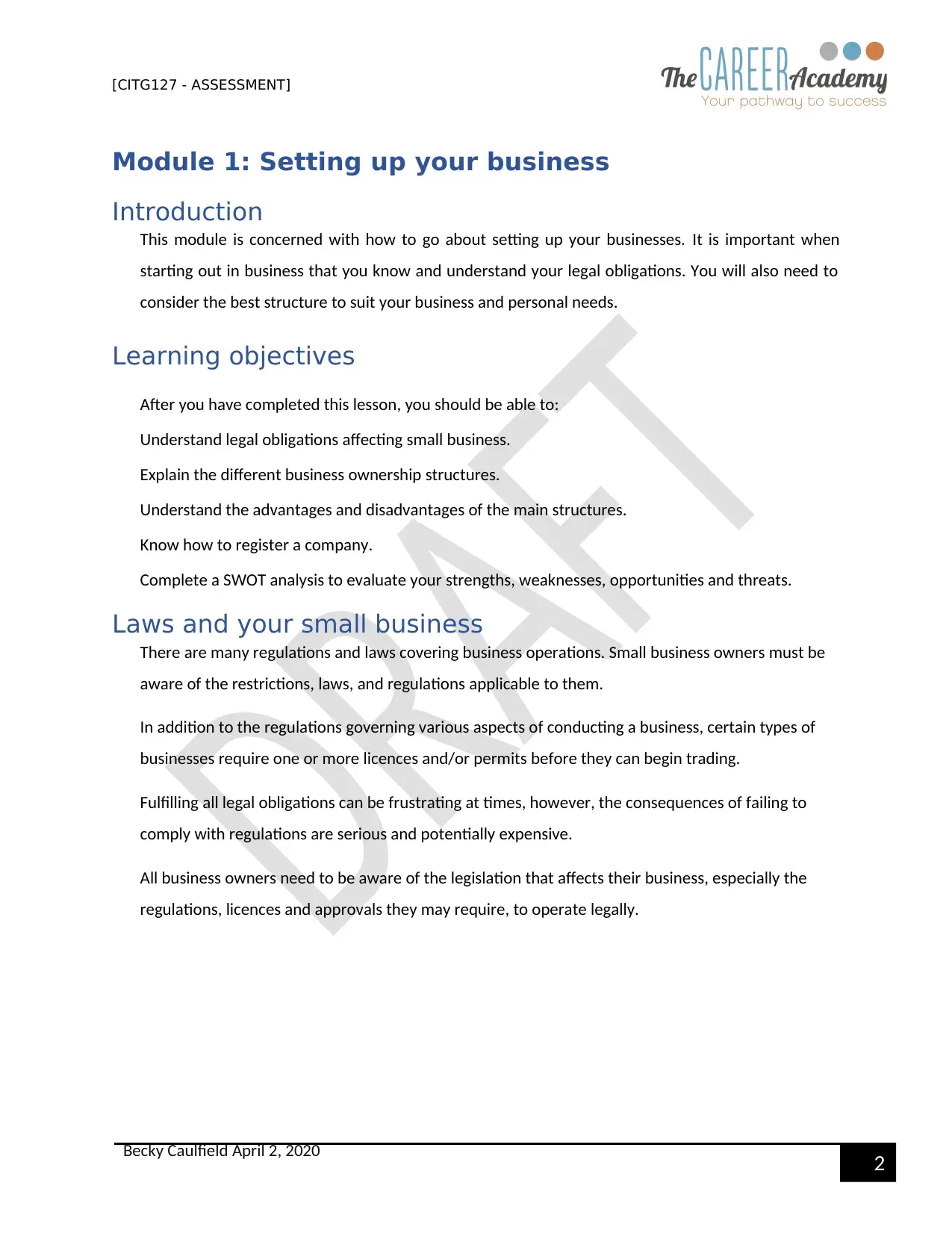
2
Becky Caulfield April 2, 2020
[CITG127 - ASSESSMENT]
Module 1: Setting up your business
Introduction
This module is concerned with how to go about setting up your businesses. It is important when
starting out in business that you know and understand your legal obligations. You will also need to
consider the best structure to suit your business and personal needs.
Learning objectives
After you have completed this lesson, you should be able to:
Understand legal obligations affecting small business.
Explain the different business ownership structures.
Understand the advantages and disadvantages of the main structures.
Know how to register a company.
Complete a SWOT analysis to evaluate your strengths, weaknesses, opportunities and threats.
Laws and your small business
There are many regulations and laws covering business operations. Small business owners must be
aware of the restrictions, laws, and regulations applicable to them.
In addition to the regulations governing various aspects of conducting a business, certain types of
businesses require one or more licences and/or permits before they can begin trading.
Fulfilling all legal obligations can be frustrating at times, however, the consequences of failing to
comply with regulations are serious and potentially expensive.
All business owners need to be aware of the legislation that affects their business, especially the
regulations, licences and approvals they may require, to operate legally.
Becky Caulfield April 2, 2020
[CITG127 - ASSESSMENT]
Module 1: Setting up your business
Introduction
This module is concerned with how to go about setting up your businesses. It is important when
starting out in business that you know and understand your legal obligations. You will also need to
consider the best structure to suit your business and personal needs.
Learning objectives
After you have completed this lesson, you should be able to:
Understand legal obligations affecting small business.
Explain the different business ownership structures.
Understand the advantages and disadvantages of the main structures.
Know how to register a company.
Complete a SWOT analysis to evaluate your strengths, weaknesses, opportunities and threats.
Laws and your small business
There are many regulations and laws covering business operations. Small business owners must be
aware of the restrictions, laws, and regulations applicable to them.
In addition to the regulations governing various aspects of conducting a business, certain types of
businesses require one or more licences and/or permits before they can begin trading.
Fulfilling all legal obligations can be frustrating at times, however, the consequences of failing to
comply with regulations are serious and potentially expensive.
All business owners need to be aware of the legislation that affects their business, especially the
regulations, licences and approvals they may require, to operate legally.
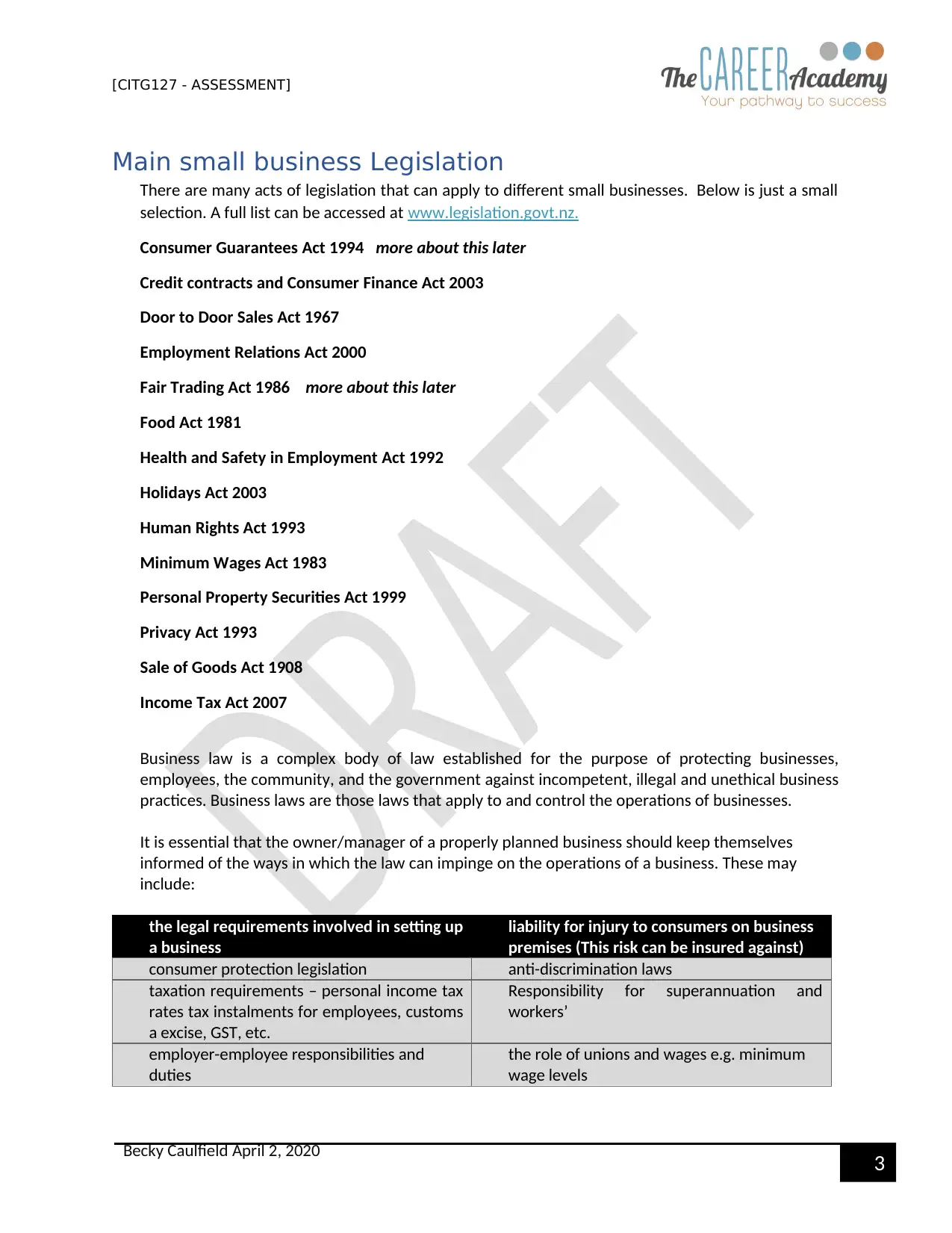
3
Becky Caulfield April 2, 2020
[CITG127 - ASSESSMENT]
Main small business Legislation
There are many acts of legislation that can apply to different small businesses. Below is just a small
selection. A full list can be accessed at www.legislation.govt.nz.
Consumer Guarantees Act 1994 more about this later
Credit contracts and Consumer Finance Act 2003
Door to Door Sales Act 1967
Employment Relations Act 2000
Fair Trading Act 1986 more about this later
Food Act 1981
Health and Safety in Employment Act 1992
Holidays Act 2003
Human Rights Act 1993
Minimum Wages Act 1983
Personal Property Securities Act 1999
Privacy Act 1993
Sale of Goods Act 1908
Income Tax Act 2007
Business law is a complex body of law established for the purpose of protecting businesses,
employees, the community, and the government against incompetent, illegal and unethical business
practices. Business laws are those laws that apply to and control the operations of businesses.
It is essential that the owner/manager of a properly planned business should keep themselves
informed of the ways in which the law can impinge on the operations of a business. These may
include:
the legal requirements involved in setting up
a business
liability for injury to consumers on business
premises (This risk can be insured against)
consumer protection legislation anti-discrimination laws
taxation requirements – personal income tax
rates tax instalments for employees, customs
a excise, GST, etc.
Responsibility for superannuation and
workers’
employer-employee responsibilities and
duties
the role of unions and wages e.g. minimum
wage levels
Becky Caulfield April 2, 2020
[CITG127 - ASSESSMENT]
Main small business Legislation
There are many acts of legislation that can apply to different small businesses. Below is just a small
selection. A full list can be accessed at www.legislation.govt.nz.
Consumer Guarantees Act 1994 more about this later
Credit contracts and Consumer Finance Act 2003
Door to Door Sales Act 1967
Employment Relations Act 2000
Fair Trading Act 1986 more about this later
Food Act 1981
Health and Safety in Employment Act 1992
Holidays Act 2003
Human Rights Act 1993
Minimum Wages Act 1983
Personal Property Securities Act 1999
Privacy Act 1993
Sale of Goods Act 1908
Income Tax Act 2007
Business law is a complex body of law established for the purpose of protecting businesses,
employees, the community, and the government against incompetent, illegal and unethical business
practices. Business laws are those laws that apply to and control the operations of businesses.
It is essential that the owner/manager of a properly planned business should keep themselves
informed of the ways in which the law can impinge on the operations of a business. These may
include:
the legal requirements involved in setting up
a business
liability for injury to consumers on business
premises (This risk can be insured against)
consumer protection legislation anti-discrimination laws
taxation requirements – personal income tax
rates tax instalments for employees, customs
a excise, GST, etc.
Responsibility for superannuation and
workers’
employer-employee responsibilities and
duties
the role of unions and wages e.g. minimum
wage levels
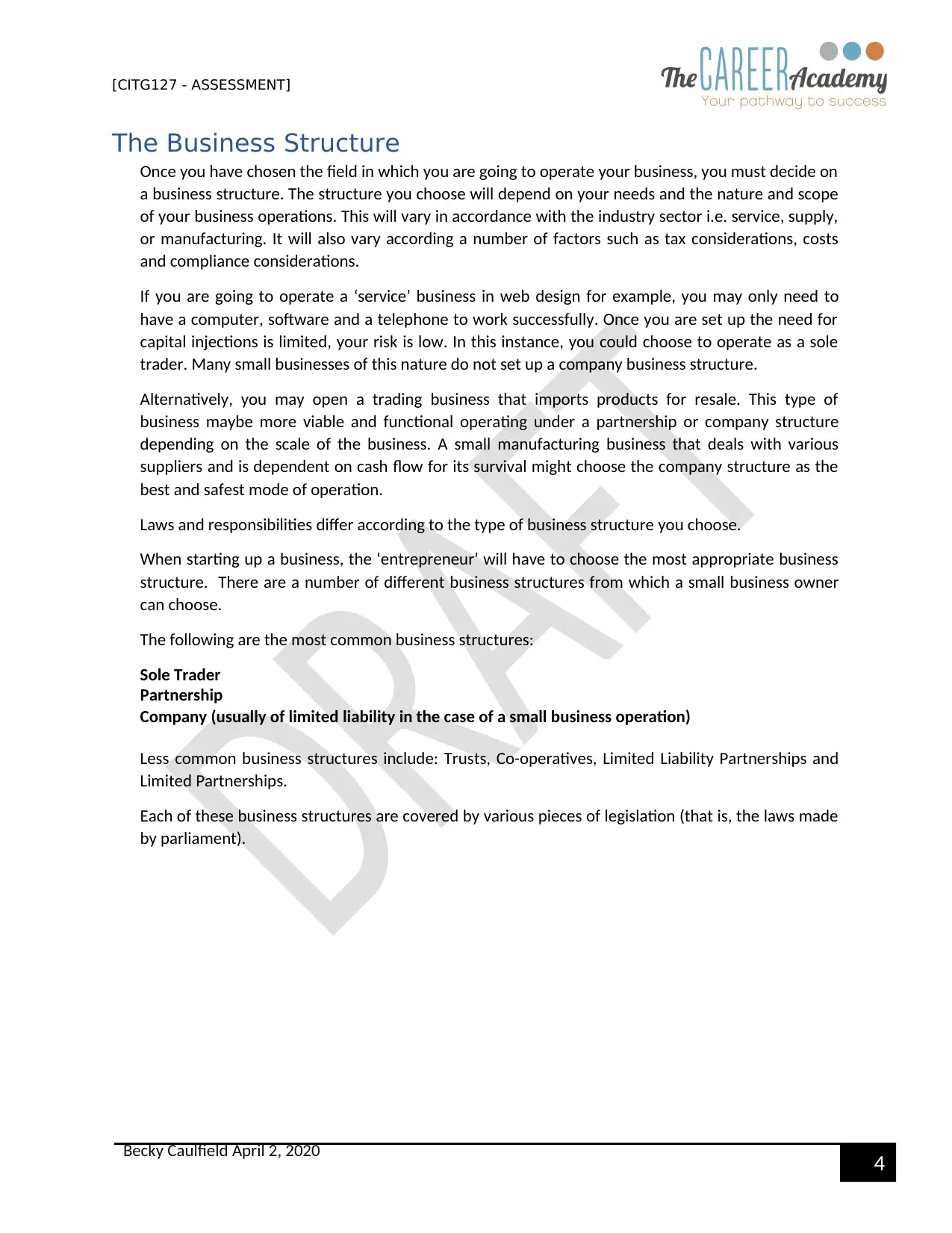
4
Becky Caulfield April 2, 2020
[CITG127 - ASSESSMENT]
The Business Structure
Once you have chosen the field in which you are going to operate your business, you must decide on
a business structure. The structure you choose will depend on your needs and the nature and scope
of your business operations. This will vary in accordance with the industry sector i.e. service, supply,
or manufacturing. It will also vary according a number of factors such as tax considerations, costs
and compliance considerations.
If you are going to operate a ‘service’ business in web design for example, you may only need to
have a computer, software and a telephone to work successfully. Once you are set up the need for
capital injections is limited, your risk is low. In this instance, you could choose to operate as a sole
trader. Many small businesses of this nature do not set up a company business structure.
Alternatively, you may open a trading business that imports products for resale. This type of
business maybe more viable and functional operating under a partnership or company structure
depending on the scale of the business. A small manufacturing business that deals with various
suppliers and is dependent on cash flow for its survival might choose the company structure as the
best and safest mode of operation.
Laws and responsibilities differ according to the type of business structure you choose.
When starting up a business, the ‘entrepreneur’ will have to choose the most appropriate business
structure. There are a number of different business structures from which a small business owner
can choose.
The following are the most common business structures:
Sole Trader
Partnership
Company (usually of limited liability in the case of a small business operation)
Less common business structures include: Trusts, Co-operatives, Limited Liability Partnerships and
Limited Partnerships.
Each of these business structures are covered by various pieces of legislation (that is, the laws made
by parliament).
Becky Caulfield April 2, 2020
[CITG127 - ASSESSMENT]
The Business Structure
Once you have chosen the field in which you are going to operate your business, you must decide on
a business structure. The structure you choose will depend on your needs and the nature and scope
of your business operations. This will vary in accordance with the industry sector i.e. service, supply,
or manufacturing. It will also vary according a number of factors such as tax considerations, costs
and compliance considerations.
If you are going to operate a ‘service’ business in web design for example, you may only need to
have a computer, software and a telephone to work successfully. Once you are set up the need for
capital injections is limited, your risk is low. In this instance, you could choose to operate as a sole
trader. Many small businesses of this nature do not set up a company business structure.
Alternatively, you may open a trading business that imports products for resale. This type of
business maybe more viable and functional operating under a partnership or company structure
depending on the scale of the business. A small manufacturing business that deals with various
suppliers and is dependent on cash flow for its survival might choose the company structure as the
best and safest mode of operation.
Laws and responsibilities differ according to the type of business structure you choose.
When starting up a business, the ‘entrepreneur’ will have to choose the most appropriate business
structure. There are a number of different business structures from which a small business owner
can choose.
The following are the most common business structures:
Sole Trader
Partnership
Company (usually of limited liability in the case of a small business operation)
Less common business structures include: Trusts, Co-operatives, Limited Liability Partnerships and
Limited Partnerships.
Each of these business structures are covered by various pieces of legislation (that is, the laws made
by parliament).
Secure Best Marks with AI Grader
Need help grading? Try our AI Grader for instant feedback on your assignments.
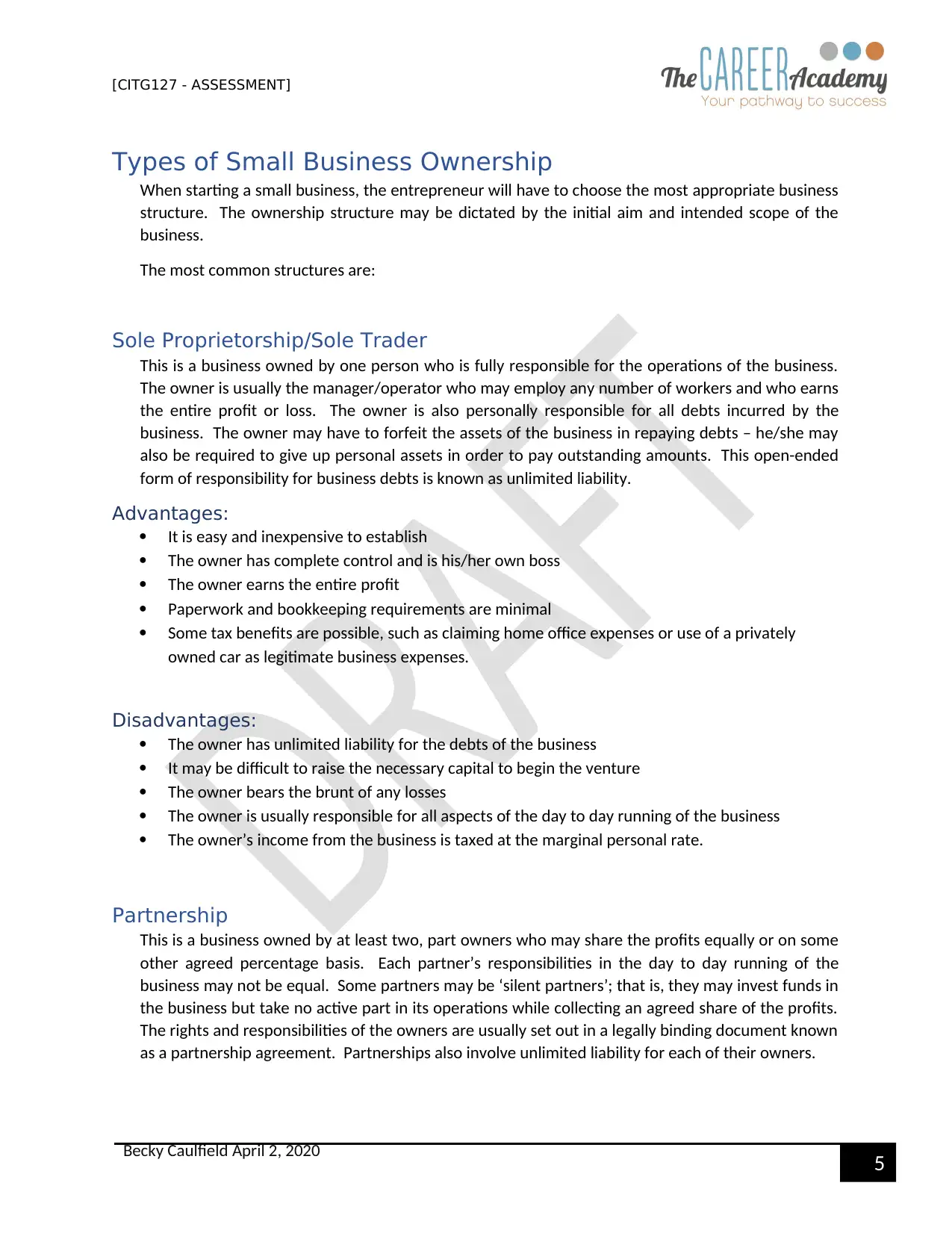
5
Becky Caulfield April 2, 2020
[CITG127 - ASSESSMENT]
Types of Small Business Ownership
When starting a small business, the entrepreneur will have to choose the most appropriate business
structure. The ownership structure may be dictated by the initial aim and intended scope of the
business.
The most common structures are:
Sole Proprietorship/Sole Trader
This is a business owned by one person who is fully responsible for the operations of the business.
The owner is usually the manager/operator who may employ any number of workers and who earns
the entire profit or loss. The owner is also personally responsible for all debts incurred by the
business. The owner may have to forfeit the assets of the business in repaying debts – he/she may
also be required to give up personal assets in order to pay outstanding amounts. This open-ended
form of responsibility for business debts is known as unlimited liability.
Advantages:
It is easy and inexpensive to establish
The owner has complete control and is his/her own boss
The owner earns the entire profit
Paperwork and bookkeeping requirements are minimal
Some tax benefits are possible, such as claiming home office expenses or use of a privately
owned car as legitimate business expenses.
Disadvantages:
The owner has unlimited liability for the debts of the business
It may be difficult to raise the necessary capital to begin the venture
The owner bears the brunt of any losses
The owner is usually responsible for all aspects of the day to day running of the business
The owner’s income from the business is taxed at the marginal personal rate.
Partnership
This is a business owned by at least two, part owners who may share the profits equally or on some
other agreed percentage basis. Each partner’s responsibilities in the day to day running of the
business may not be equal. Some partners may be ‘silent partners’; that is, they may invest funds in
the business but take no active part in its operations while collecting an agreed share of the profits.
The rights and responsibilities of the owners are usually set out in a legally binding document known
as a partnership agreement. Partnerships also involve unlimited liability for each of their owners.
Becky Caulfield April 2, 2020
[CITG127 - ASSESSMENT]
Types of Small Business Ownership
When starting a small business, the entrepreneur will have to choose the most appropriate business
structure. The ownership structure may be dictated by the initial aim and intended scope of the
business.
The most common structures are:
Sole Proprietorship/Sole Trader
This is a business owned by one person who is fully responsible for the operations of the business.
The owner is usually the manager/operator who may employ any number of workers and who earns
the entire profit or loss. The owner is also personally responsible for all debts incurred by the
business. The owner may have to forfeit the assets of the business in repaying debts – he/she may
also be required to give up personal assets in order to pay outstanding amounts. This open-ended
form of responsibility for business debts is known as unlimited liability.
Advantages:
It is easy and inexpensive to establish
The owner has complete control and is his/her own boss
The owner earns the entire profit
Paperwork and bookkeeping requirements are minimal
Some tax benefits are possible, such as claiming home office expenses or use of a privately
owned car as legitimate business expenses.
Disadvantages:
The owner has unlimited liability for the debts of the business
It may be difficult to raise the necessary capital to begin the venture
The owner bears the brunt of any losses
The owner is usually responsible for all aspects of the day to day running of the business
The owner’s income from the business is taxed at the marginal personal rate.
Partnership
This is a business owned by at least two, part owners who may share the profits equally or on some
other agreed percentage basis. Each partner’s responsibilities in the day to day running of the
business may not be equal. Some partners may be ‘silent partners’; that is, they may invest funds in
the business but take no active part in its operations while collecting an agreed share of the profits.
The rights and responsibilities of the owners are usually set out in a legally binding document known
as a partnership agreement. Partnerships also involve unlimited liability for each of their owners.
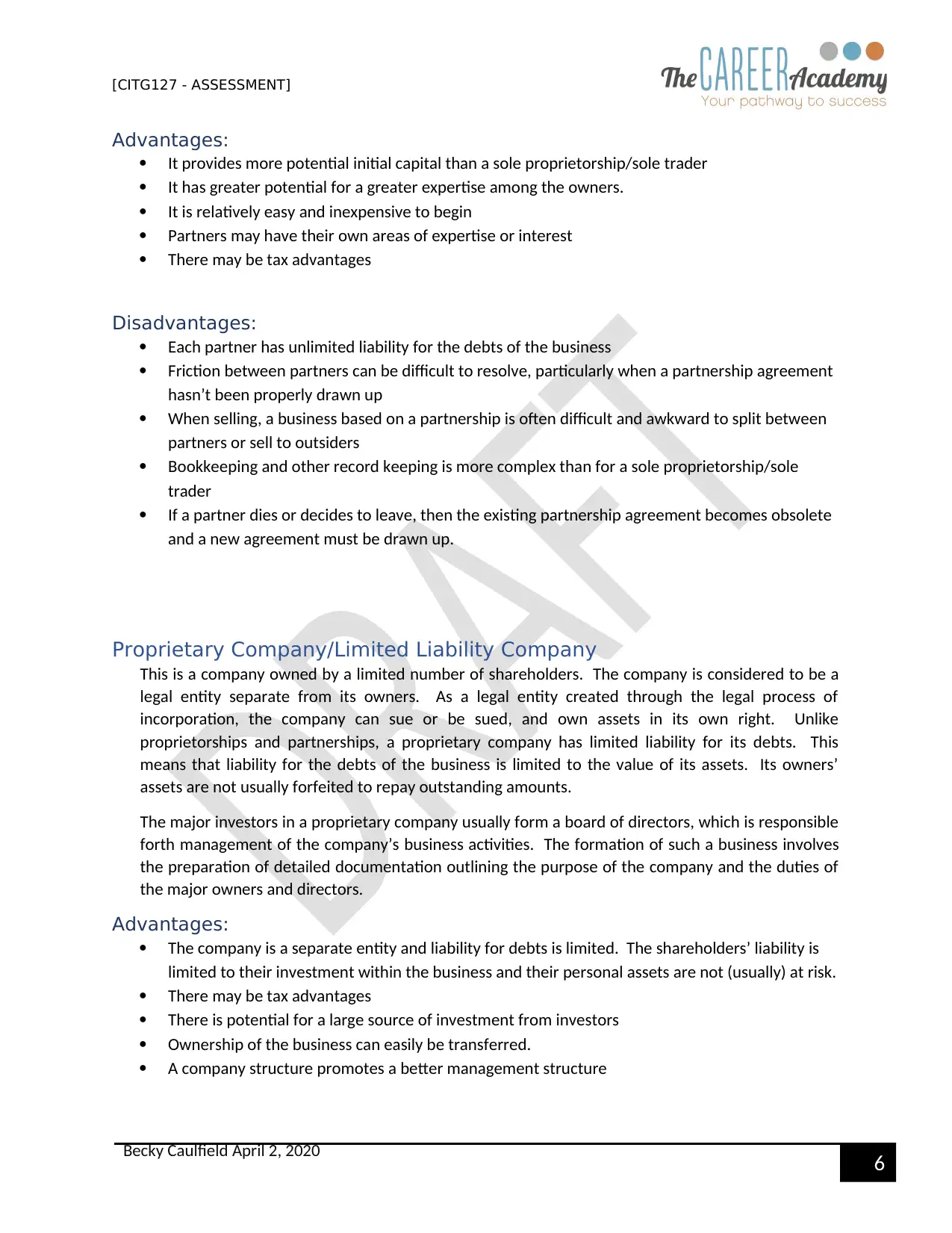
6
Becky Caulfield April 2, 2020
[CITG127 - ASSESSMENT]
Advantages:
It provides more potential initial capital than a sole proprietorship/sole trader
It has greater potential for a greater expertise among the owners.
It is relatively easy and inexpensive to begin
Partners may have their own areas of expertise or interest
There may be tax advantages
Disadvantages:
Each partner has unlimited liability for the debts of the business
Friction between partners can be difficult to resolve, particularly when a partnership agreement
hasn’t been properly drawn up
When selling, a business based on a partnership is often difficult and awkward to split between
partners or sell to outsiders
Bookkeeping and other record keeping is more complex than for a sole proprietorship/sole
trader
If a partner dies or decides to leave, then the existing partnership agreement becomes obsolete
and a new agreement must be drawn up.
Proprietary Company/Limited Liability Company
This is a company owned by a limited number of shareholders. The company is considered to be a
legal entity separate from its owners. As a legal entity created through the legal process of
incorporation, the company can sue or be sued, and own assets in its own right. Unlike
proprietorships and partnerships, a proprietary company has limited liability for its debts. This
means that liability for the debts of the business is limited to the value of its assets. Its owners’
assets are not usually forfeited to repay outstanding amounts.
The major investors in a proprietary company usually form a board of directors, which is responsible
forth management of the company’s business activities. The formation of such a business involves
the preparation of detailed documentation outlining the purpose of the company and the duties of
the major owners and directors.
Advantages:
The company is a separate entity and liability for debts is limited. The shareholders’ liability is
limited to their investment within the business and their personal assets are not (usually) at risk.
There may be tax advantages
There is potential for a large source of investment from investors
Ownership of the business can easily be transferred.
A company structure promotes a better management structure
Becky Caulfield April 2, 2020
[CITG127 - ASSESSMENT]
Advantages:
It provides more potential initial capital than a sole proprietorship/sole trader
It has greater potential for a greater expertise among the owners.
It is relatively easy and inexpensive to begin
Partners may have their own areas of expertise or interest
There may be tax advantages
Disadvantages:
Each partner has unlimited liability for the debts of the business
Friction between partners can be difficult to resolve, particularly when a partnership agreement
hasn’t been properly drawn up
When selling, a business based on a partnership is often difficult and awkward to split between
partners or sell to outsiders
Bookkeeping and other record keeping is more complex than for a sole proprietorship/sole
trader
If a partner dies or decides to leave, then the existing partnership agreement becomes obsolete
and a new agreement must be drawn up.
Proprietary Company/Limited Liability Company
This is a company owned by a limited number of shareholders. The company is considered to be a
legal entity separate from its owners. As a legal entity created through the legal process of
incorporation, the company can sue or be sued, and own assets in its own right. Unlike
proprietorships and partnerships, a proprietary company has limited liability for its debts. This
means that liability for the debts of the business is limited to the value of its assets. Its owners’
assets are not usually forfeited to repay outstanding amounts.
The major investors in a proprietary company usually form a board of directors, which is responsible
forth management of the company’s business activities. The formation of such a business involves
the preparation of detailed documentation outlining the purpose of the company and the duties of
the major owners and directors.
Advantages:
The company is a separate entity and liability for debts is limited. The shareholders’ liability is
limited to their investment within the business and their personal assets are not (usually) at risk.
There may be tax advantages
There is potential for a large source of investment from investors
Ownership of the business can easily be transferred.
A company structure promotes a better management structure
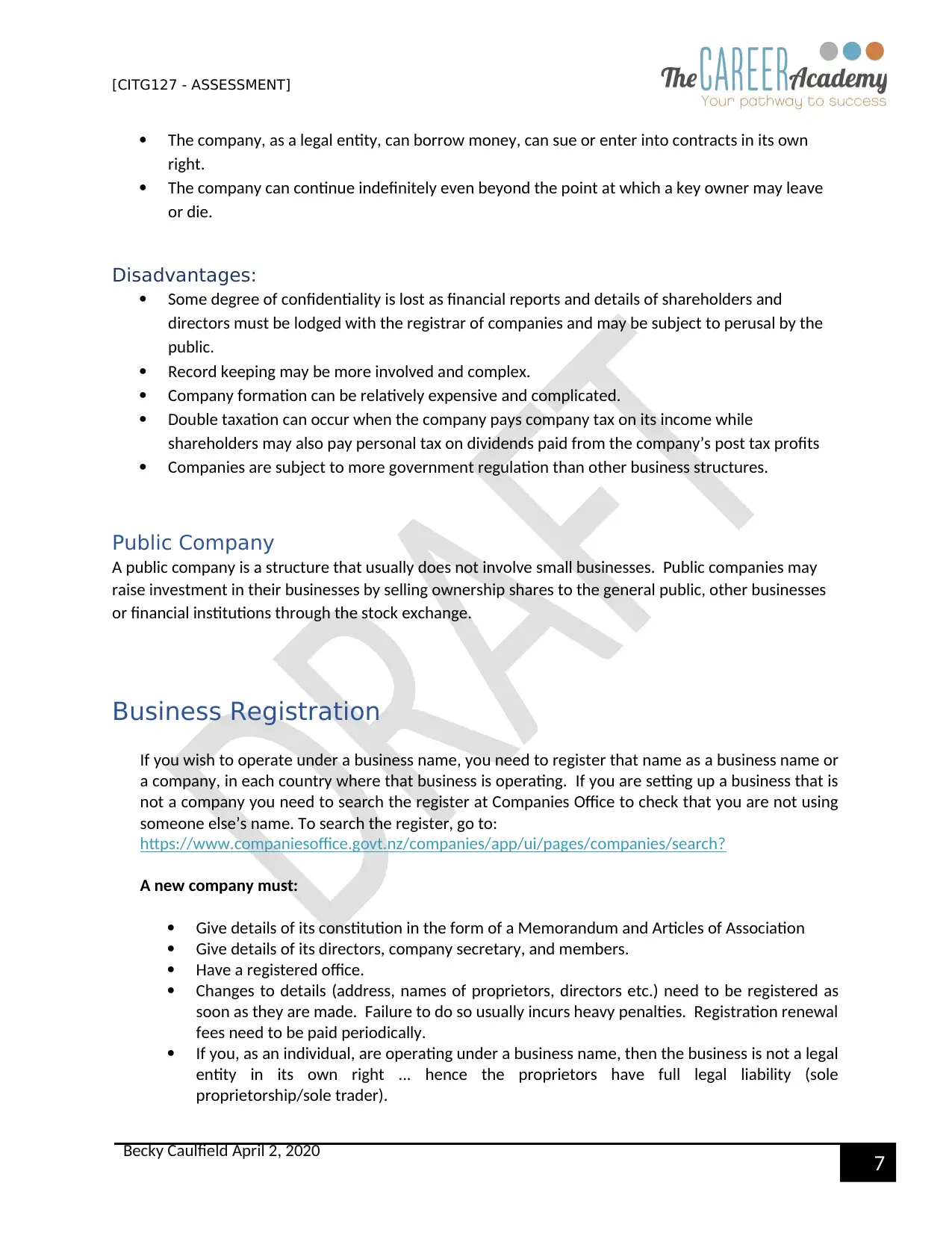
7
Becky Caulfield April 2, 2020
[CITG127 - ASSESSMENT]
The company, as a legal entity, can borrow money, can sue or enter into contracts in its own
right.
The company can continue indefinitely even beyond the point at which a key owner may leave
or die.
Disadvantages:
Some degree of confidentiality is lost as financial reports and details of shareholders and
directors must be lodged with the registrar of companies and may be subject to perusal by the
public.
Record keeping may be more involved and complex.
Company formation can be relatively expensive and complicated.
Double taxation can occur when the company pays company tax on its income while
shareholders may also pay personal tax on dividends paid from the company’s post tax profits
Companies are subject to more government regulation than other business structures.
Public Company
A public company is a structure that usually does not involve small businesses. Public companies may
raise investment in their businesses by selling ownership shares to the general public, other businesses
or financial institutions through the stock exchange.
Business Registration
If you wish to operate under a business name, you need to register that name as a business name or
a company, in each country where that business is operating. If you are setting up a business that is
not a company you need to search the register at Companies Office to check that you are not using
someone else’s name. To search the register, go to:
https://www.companiesoffice.govt.nz/companies/app/ui/pages/companies/search?
A new company must:
Give details of its constitution in the form of a Memorandum and Articles of Association
Give details of its directors, company secretary, and members.
Have a registered office.
Changes to details (address, names of proprietors, directors etc.) need to be registered as
soon as they are made. Failure to do so usually incurs heavy penalties. Registration renewal
fees need to be paid periodically.
If you, as an individual, are operating under a business name, then the business is not a legal
entity in its own right ... hence the proprietors have full legal liability (sole
proprietorship/sole trader).
Becky Caulfield April 2, 2020
[CITG127 - ASSESSMENT]
The company, as a legal entity, can borrow money, can sue or enter into contracts in its own
right.
The company can continue indefinitely even beyond the point at which a key owner may leave
or die.
Disadvantages:
Some degree of confidentiality is lost as financial reports and details of shareholders and
directors must be lodged with the registrar of companies and may be subject to perusal by the
public.
Record keeping may be more involved and complex.
Company formation can be relatively expensive and complicated.
Double taxation can occur when the company pays company tax on its income while
shareholders may also pay personal tax on dividends paid from the company’s post tax profits
Companies are subject to more government regulation than other business structures.
Public Company
A public company is a structure that usually does not involve small businesses. Public companies may
raise investment in their businesses by selling ownership shares to the general public, other businesses
or financial institutions through the stock exchange.
Business Registration
If you wish to operate under a business name, you need to register that name as a business name or
a company, in each country where that business is operating. If you are setting up a business that is
not a company you need to search the register at Companies Office to check that you are not using
someone else’s name. To search the register, go to:
https://www.companiesoffice.govt.nz/companies/app/ui/pages/companies/search?
A new company must:
Give details of its constitution in the form of a Memorandum and Articles of Association
Give details of its directors, company secretary, and members.
Have a registered office.
Changes to details (address, names of proprietors, directors etc.) need to be registered as
soon as they are made. Failure to do so usually incurs heavy penalties. Registration renewal
fees need to be paid periodically.
If you, as an individual, are operating under a business name, then the business is not a legal
entity in its own right ... hence the proprietors have full legal liability (sole
proprietorship/sole trader).
Paraphrase This Document
Need a fresh take? Get an instant paraphrase of this document with our AI Paraphraser
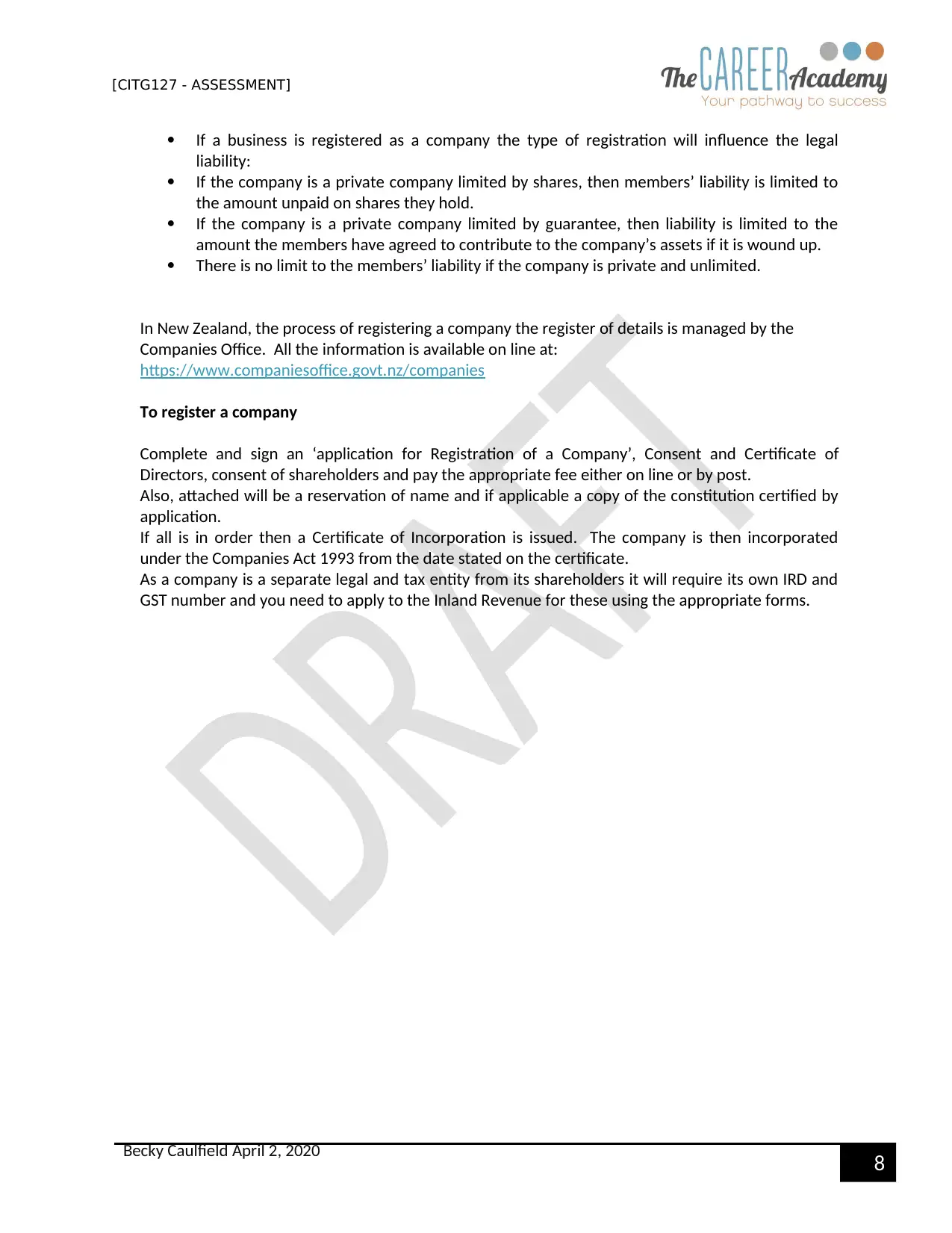
8
Becky Caulfield April 2, 2020
[CITG127 - ASSESSMENT]
If a business is registered as a company the type of registration will influence the legal
liability:
If the company is a private company limited by shares, then members’ liability is limited to
the amount unpaid on shares they hold.
If the company is a private company limited by guarantee, then liability is limited to the
amount the members have agreed to contribute to the company’s assets if it is wound up.
There is no limit to the members’ liability if the company is private and unlimited.
In New Zealand, the process of registering a company the register of details is managed by the
Companies Office. All the information is available on line at:
https://www.companiesoffice.govt.nz/companies
To register a company
Complete and sign an ‘application for Registration of a Company’, Consent and Certificate of
Directors, consent of shareholders and pay the appropriate fee either on line or by post.
Also, attached will be a reservation of name and if applicable a copy of the constitution certified by
application.
If all is in order then a Certificate of Incorporation is issued. The company is then incorporated
under the Companies Act 1993 from the date stated on the certificate.
As a company is a separate legal and tax entity from its shareholders it will require its own IRD and
GST number and you need to apply to the Inland Revenue for these using the appropriate forms.
Becky Caulfield April 2, 2020
[CITG127 - ASSESSMENT]
If a business is registered as a company the type of registration will influence the legal
liability:
If the company is a private company limited by shares, then members’ liability is limited to
the amount unpaid on shares they hold.
If the company is a private company limited by guarantee, then liability is limited to the
amount the members have agreed to contribute to the company’s assets if it is wound up.
There is no limit to the members’ liability if the company is private and unlimited.
In New Zealand, the process of registering a company the register of details is managed by the
Companies Office. All the information is available on line at:
https://www.companiesoffice.govt.nz/companies
To register a company
Complete and sign an ‘application for Registration of a Company’, Consent and Certificate of
Directors, consent of shareholders and pay the appropriate fee either on line or by post.
Also, attached will be a reservation of name and if applicable a copy of the constitution certified by
application.
If all is in order then a Certificate of Incorporation is issued. The company is then incorporated
under the Companies Act 1993 from the date stated on the certificate.
As a company is a separate legal and tax entity from its shareholders it will require its own IRD and
GST number and you need to apply to the Inland Revenue for these using the appropriate forms.
1 out of 8
Related Documents
Your All-in-One AI-Powered Toolkit for Academic Success.
+13062052269
info@desklib.com
Available 24*7 on WhatsApp / Email
![[object Object]](/_next/static/media/star-bottom.7253800d.svg)
Unlock your academic potential
© 2024 | Zucol Services PVT LTD | All rights reserved.



